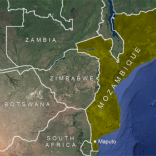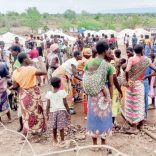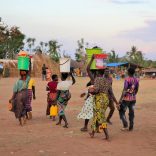Mozambique: Chronic malnutrition, food insecurity levels continue - NGO
Massingir Dam to increase discharges to try save rice harvest

Macauhub (File) / Massingir Dam
The Massingir dam, in the southern Mozambican province of Gaza, has decided to increase its discharges in an attempt to save the rice harvest in the Limpopo Valley.
The dam is located on the Elephants River, which is the main tributary of the Limpopo. In principle, the dam reservoir should guarantee water for the large irrigation schemes on the Limpopo in Chokwe and Xai-Xai districts. But ever since its construction in the colonial era, the dam has been plagued with structural problems.
Nonetheless, when Prime Minister Carlos Agostinho do Rosario visited Massingir on Friday, the director of the dam rehabilitation project, Luis Paulo, told him that emergency discharges, of 27 cubic metres a second, begun on 2 February, sought to meet the water requirements of crops in the Limpopo Valley and thus save this year’s harvest.
Cited by Radio Mozambique, he said that the discharges will continue to be made while work continues on repairing the dam’s bottom outlet.
The bottom outlet was severely damaged in May 2008 due to bungled work by the French firm Coyne et Bellier, and BKS Consulting Engineers of South Africa. During the accident, pipes in the bottom outlet ruptured. Now a further attempt is being made to repair the outlet.
There are two pipes in the bottom outlet, one of which is now being used to discharge water into the river. According to the managing director of the Southern Regional Water Board (ARA-Sul), Helio Banze, this will increase the time required to repair the bottom outlet.
The dam management says there is no other way to make the water stored in the reservoir available. Because of the drought the water simply does not reach the surface spillways. Staff are watching the situation closely, to ensure that the current discharges do not further compromise the bottom outlet.
United Nations agencies describe the current El Nino as one of the strongest in the past half century. A release issued by the World Food Programme (WFP), the Food and Agriculture Organisation (FAO), the Famine Early Warning Systems Network (FEWSNET) and the European Commission’s Joint Research Centre (JRC) notes that “across large swathes of Zimbabwe, Malawi, Zambia, South Africa, Mozambique, Botswana and Madagascar, the current rainfall season has so far been the driest in the last 35 years”.
“Much of the southern African sub-region has consequently experienced significant delays in planting and very poor conditions for early crop development and pasture re-growth”, the release added. “In many areas, planting has not been possible due to 30 to 50 day delays in the onset of seasonal rains resulting in widespread crop failure. Although there has been some relief since mid-January in certain areas, the window of opportunity for the successful planting of crops under rain-fed conditions is nearly closed”.
Even if there is now normal rainfall for what remains of the rainy season, the forecast remains pessimistic. “Crop water balance models indicate poor performance of maize over a widespread area”, the release warns.
But it is most unlikely that there will be a sudden return to normal rainfall. Instead the seasonal forecasts are for “a continuation of below-average rainfall and above-average temperatures across most of the region for the remainder of the growing season”.
The release’s grim conclusion is that “the combination of a poor 2014-2015 season, an extremely dry early season (October to December) and forecasts for continuing hot and drier-than-average conditions through mid-2016, suggest a scenario of extensive, regional-scale crop failure”.
“This has increased the region’s vulnerability due to the depletion of regional cereal stocks and higher-than-average food prices, and has substantially increased food insecurity”, the agencies add. “Even before the current crisis began, the number of food-insecure people in the region (not including South Africa), already stood at 14 million, according to the South African Development Community (SADC)”.
The FEWSNET estimate of early February is that at least 2.5 million people are now in a critical situation “and require urgent humanitarian assistance to protect livelihoods and household food consumption”.
The release warns that “over the coming year, humanitarian partners should prepare themselves for food insecurity levels and food insecure population numbers in southern Africa to be at their highest levels since the 2002-2003 food crisis”.













Leave a Reply
Be the First to Comment!
You must be logged in to post a comment.
You must be logged in to post a comment.